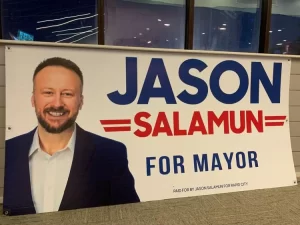Rapid City elected a new mayor this week from a field of five candidates. I wish incoming Mayor Jason Salamun the best. However, it is important to note that he enters office with only 32% of the vote; two thirds of voters picked someone else. This outcome exposes the shortcomings of the voting system used for the election.

Like Sioux Falls, Rapid City has an outdated election system which can frustrate the intentions of voters. Unfortunately, those in power in both cities tend to cling to the outdated election systems that perpetuate their hold on power.
Unlike Rapid City, Sioux Falls utilizes an expensive runoff election system whenever a candidate fails to secure over 50% of the vote. This scenario often arises when multiple candidates compete for a single office, as was the case in the recent mayoral election in Rapid City.
Moreover, plurality elections, due to the “spoiler effect,” can lead to unexpected outcomes. Sioux Falls voters experienced this phenomenon in the six candidate 2010 mayoral election, which resulted in a runoff between the most right-wing candidate and the only Democrat, as the other candidates effectively canceled each other out by splitting the vote of those who desired a moderate mayor.
South Dakota Uses an Old-Fashioned System for Local Elections
The imperfect plurality voting system used in South Dakota for local elections allows voters to pick one and only one candidate. That approach can produce odd results and undermine voters’ intentions when multiple candidates are involved. Fortunately, there are superior election systems available for selecting leaders and representatives.
Ranking is Better When You Have Multiple Options
Instant runoff voting, also known as or ranked choice voting, is a viable alternative. It is growing in popularity nationwide. When there are multiple candidates, voters simply rank as many as they desire, in order of preference. During the counting process, less popular candidates are gradually eliminated, and their votes are reassigned to the voter’s next favorite candidate until a candidate reaches 50% of the vote.

Ranked choice voting is used in municipal elections around the country including five cities in Minnesota. It produces winners who are generally acceptable to most voters. And it encourages candidates to tailor their messages to appeal to all voters, not just their own constituencies. It has the added benefit of avoiding expensive, low-turnout runoff elections.
With Approval Voting, You Vote for All Candidates You Like
Approval voting is another good alternative. Approval voting ballots look very similar to traditional plurality voting ballots, but they allow voters to choose multiple candidates for an office. Voters can indicate approval for all candidates they support and withhold their vote from any they don’t approve of. This system grants voters the freedom to say “yes” or “no” to every candidate, rather than being limited to selecting just one.
Approval voting better captures the intent of voters and ensures that popular candidates win. With approval voting, each voter may choose (approve) any number of candidates, and the winner is the one approved by the largest number of voters. Ultimately, the winner is both popular and likely to beat all rivals head-to-head.
Fargo Uses Approval Voting
Candidates are rewarded for appealing to a wide swath of the electorate. They tend to attack less and collaborate more. More candidates seem to run. Candidates who alienate some segment of the population likely may struggle. And approval voting eliminates the spoiler effect that plagues plurality voting.
Fargo, the second largest city in the Dakotas, uses approval voting. Voters like it. In the 2022 Fargo mayor’s election a clear consensus winner easily emerged from a field of seven candidates. The incumbent was approved by 64.5% of voters, resulting in a popular winner while saving the city, the candidates and the voters from an expensive runoff election.
Spoiler Effect Eliminated
Both ranked choice voting and approval voting eliminate the spoiler effect, avoid the need for expensive runoff elections and promise to produce winners who reflect the will of the people. And while they don’t change who runs or who gets elected, they have the potential to improve candidate messaging and motivation.
Local Leaders Can Choose a Better Election System
Unfortunately, the South Dakota legislature recently passed legislation banning ranked choice voting, so it is not currently an option for our cities. But according to a 2022 attorney general’s opinion, approval voting is allowed.
Looking ahead, Sioux Falls has a big city election in 2026. As Mayor TenHaken is term limited, a new mayor will be selected, probably from a field of multiple candidates. Unless the city council acts before then, voters may not be able to elect the most popular candidate.
Congratulations and good luck, Mayor Salamun! I hope you and city leaders in Sioux Falls consider fixing the outdated local election systems before the next round of important city elections.
I would agree on this scenario if there was a runoff or approval voting, Armstrong probably would have prevailed. There was one glimmer of light and hope in the RC election though, the 2 biggest money candidates lost.
Can you imagine the chaos it would
cause if our state allowed the most popular candidate to be elected?
What would we fight about?
How would politicians raise money?